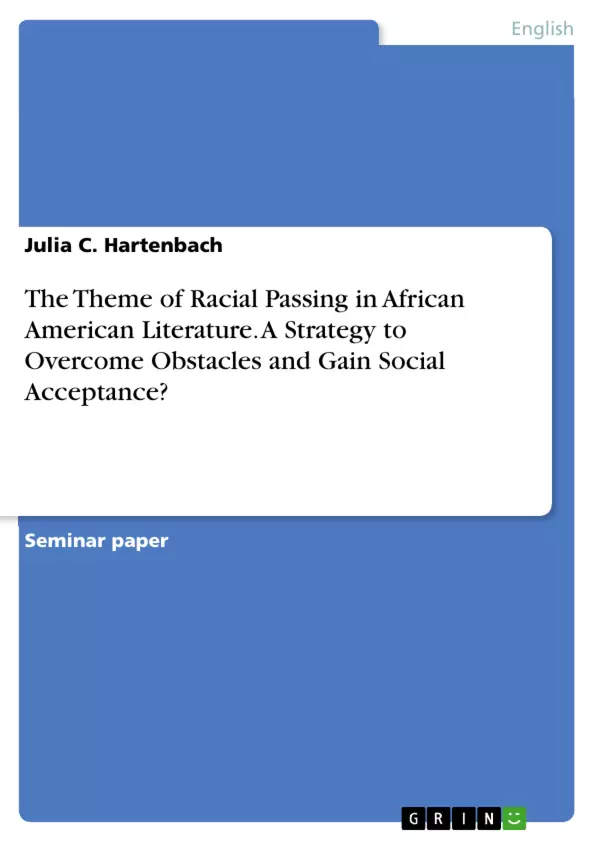In this paper, I will examine the theme of racial passing in African American narratives more closely by defining the term ‘passing’ more explicitly, and by giving a brief overview of the historical circumstances that led light-skinned African Americans to pass as white. Subsequently, I will focus on how racial passing is represented in literature written by African American authors. Therefore, I chose two novels that are commonly considered to be quintessential texts dealing with the phenomenon of racial passing, namely James Weldon Johnson’s The Autobiography of An Ex-Colored Man and Nella Larsen’s Passing. I will argue that the process of racial passing is an ongoing one, proceeding in three stages ...
Inhaltsverzeichnis (Table of Contents)
- Introduction
- Historical Background
- A Comparison of Passing in J.W. Johnson's The Autobiography Of An Ex-Colored Man and Nella Larsen's Passing
- Passing in James Weldon Johnson's The Autobiography Of An Ex-Colored Man
- Passing in Nella Larsen's Passing
- Conclusion
Zielsetzung und Themenschwerpunkte (Objectives and Key Themes)
This paper aims to examine the theme of racial passing in African American narratives by defining the term 'passing' and providing a historical overview of the circumstances leading light-skinned African Americans to pass as white. It analyzes how racial passing is represented in literature, specifically focusing on James Weldon Johnson's The Autobiography of An Ex-Colored Man and Nella Larsen's Passing. The paper argues that racial passing is a three-stage process: an event triggering the idea of passing, an initial phase of happiness associated with overcoming social obstacles, and finally, a constant internal struggle for identity due to the denied identity.
- The historical context and development of racial passing in the United States.
- The social and economic factors that motivated African Americans to pass as white.
- The psychological and emotional implications of racial passing on individuals.
- The representation of racial passing in literature, specifically through the novels of James Weldon Johnson and Nella Larsen.
- The complex relationship between racial passing and the concept of identity.
Zusammenfassung der Kapitel (Chapter Summaries)
- Introduction: This chapter introduces the concept of racial passing, exploring its motivations and consequences based on the quote from Nella Larsen's novel "Passing." It also outlines the paper's objectives and methodology, focusing on two key novels: James Weldon Johnson's The Autobiography of An Ex-Colored Man and Nella Larsen's Passing.
- Historical Background: This chapter delves into the origins and development of racial passing, tracing its roots to the antebellum period and its prevalence during the Jim Crow era. It discusses the social and legal frameworks that shaped the phenomenon, including the 'one-drop rule' and the 1896 Plessy vs. Ferguson Supreme Court decision, which solidified racial segregation. The chapter highlights the social and political pressures that forced African Americans to pass as white to survive and gain access to opportunities denied to them by white supremacy.
Schlüsselwörter (Keywords)
This paper examines the theme of racial passing, focusing on its historical context, social motivations, and psychological implications. It analyzes the representation of racial passing in African American literature, particularly in the works of James Weldon Johnson and Nella Larsen. Key concepts explored include the "one-drop rule," Jim Crow segregation, identity formation, and the complex relationship between racial identity and social acceptance.
- Quote paper
- Julia C. Hartenbach (Author), 2016, The Theme of Racial Passing in African American Literature. A Strategy to Overcome Obstacles and Gain Social Acceptance?, Munich, GRIN Verlag, https://www.grin.com/document/442958



